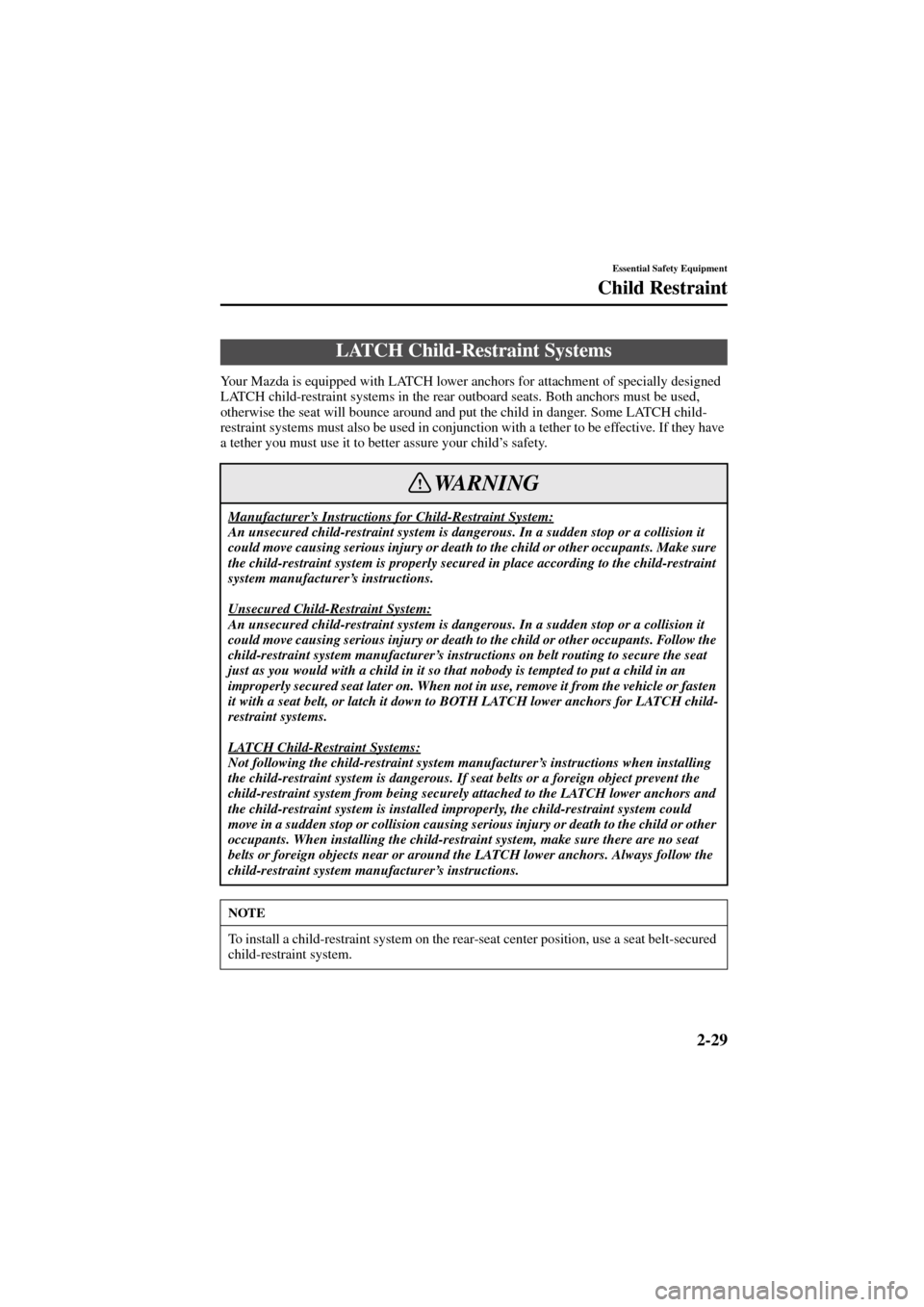Page 46 of 289

2-29
Essential Safety Equipment
Child Restraint
Form No. 8R29-EA-02I
Your Mazda is equipped with LATCH lower anchors for attachment of specially designed
LATCH child-restraint systems in the rear outboard seats. Both anchors must be used,
otherwise the seat will bounce around and put the child in danger. Some LATCH child-
restraint systems must also be used in conjunction with a tether to be effective. If they have
a tether you must use it to better assure your child’s safety.
LATCH Child-Restraint Systems
Manufacturer’s Instructions for Child-Restraint System:An unsecured child-restraint system is dangerous. In a sudden stop or a collision it
could move causing serious injury or death to the child or other occupants. Make sure
the child-restraint system is properly secured in place according to the child-restraint
system manufacturer’s instructions.
Unsecured Child-Restraint System:
An unsecured child-restraint system is dangerous. In a sudden stop or a collision it
could move causing serious injury or death to the child or other occupants. Follow the
child-restraint system manufacturer’s instructions on belt routing to secure the seat
just as you would with a child in it so that nobody is tempted to put a child in an
improperly secured seat later on. When not in use, remove it from the vehicle or fasten
it with a seat belt, or latch it down to BOTH LATCH lower anchors for LATCH child-
restraint systems.
LATCH Child-Restraint Systems:
Not following the child-restraint system manufacturer’s instructions when installing
the child-restraint system is dangerous. If seat belts or a foreign object prevent the
child-restraint system from being securely attached to the LATCH lower anchors and
the child-restraint system is installed improperly, the child-restraint system could
move in a sudden stop or collision causing serious injury or death to the child or other
occupants. When installing the child-restraint system, make sure there are no seat
belts or foreign objects near or around the LATCH lower anchors. Always follow the
child-restraint system manufacturer’s instructions.
NOTE
To install a child-restraint system on the rear-seat center position, use a seat belt-secured
child-restraint system.
WARNING
shuseizumi_J56J_8R29_EA_02I.book Page 29 Saturday, September 7, 2002 12:58 PM
Page 47 of 289

2-30
Essential Safety Equipment
Child Restraint
Form No. 8R29-EA-02I
�LATCH Child-Restraint System
Installation Procedure (Rear
Outboard Seats)
1. Expand the area between the seat
bottom and the seatback slightly to
verify the locations of the LATCH
lower anchors.
2. Secure the child-restraint system using
BOTH LATCH lower anchors,
following the child-restraint system
manufacturer’s instruction.3. If your child-restraint system came
equipped with a tether, that probably
means it is very important to properly
secure the tether for child safety, please
carefully follow the child-restraint
system manufacturer’s instructions
when installing tethers.
NOTE
The markings above the LATCH lower
anchors indicate the locations of
LATCH lower anchors for the
attachment of a child-restraint system.
LATCH
lower anchorMarking
For rear left seat
For rear
right seat
Child-Restraint Tether Usage:Using the tether to secure anything
but a child-restraint system is
dangerous. This could weaken or
damage the tether or tether anchor
and result in injury. Use the tether
and tether anchor only for a child-
restraint system.
For rear right seatFor rear left seat
Anchor bracket
location
CoverOpen
Anchor
bracket
Tether strap
positionTether strap
WARNING
shuseizumi_J56J_8R29_EA_02I.book Page 30 Saturday, September 7, 2002 12:58 PM
Page 49 of 289

2-32
Essential Safety Equipment
SRS Air Bags
Form No. 8R29-EA-02I
Small children should be protected by a child-restraint system. In certain regions, larger
children must use a child-restraint system (page 2-21).
Carefully consider which child-restraint system is necessary for your child and follow the
installation directions in this Owner’s Manual as well as the child-restraint system
manufacturer’s instructions.
Air Bags without Seat Belts:Depending only on the air bags for protection during an accident is dangerous.
Alone, air bags may not prevent serious injuries. The appropriate air bags can be
expected to inflate only in collisions with frontal, near frontal or side forces that are at
least moderate. Vehicle occupants should always wear seat belts.
Child in the Front Seat:
Placing a child, 12 years or under, in the front seat is dangerous. The child could be
hit by a deploying air bag and be seriously injured or even killed. A sleeping child is
more likely to lean against the door and be hit by the side air bag in a moderate, right-
side collision. Whenever possible, always secure a child 12 years and under on the
rear seat with an appropriate child-restraint system for the child’s age and size.
Rear-Facing Child-Restraint System:
Rear-facing child-restraint systems on the front seat are particularly dangerous.
The child-restraint system can be hit by a deploying air bag and moved violently
backward resulting in serious injury or death to the child. NEVER use a rear-facing
child-restraint system in the front seat with an air bag that could deploy.
Seating Position with Front Air Bags:
Sitting too close to the air bag storage compartments or placing hands or feet on them
is extremely dangerous. Front Air bags inflate with great force and speed. Serious
injuries could occur if someone is too close. The driver should always hold onto only
the rim of the steering wheel. The front seat passenger should keep both feet on the
floor. Front seat occupants should adjust their seats as far back as possible and
always sit upright against the seatbacks with seat belts worn properly.
WARNING
Deploying air bag
shuseizumi_J56J_8R29_EA_02I.book Page 32 Saturday, September 7, 2002 12:58 PM
Page:
< prev 1-8 9-16 17-24